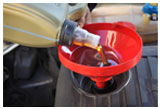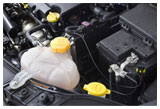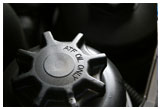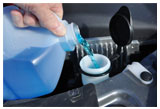 Everyone knows that without gas your vehicle won’t run.Most people also know that oil is important.
Everyone knows that without gas your vehicle won’t run.Most people also know that oil is important. Engine oil lubricates, cleans, and cools critical parts of the engine. The oil's additives also help to suspend dirt, where it can be drained at the next oil change. The life-blood of your engine, engine oil consists of various weight mineral or synthetic oils combined with additives for engine protection. Oils may come in single or multi-grades and meet various oil performance standards. Multi-grade oils usually start out as single-grade base oils, such as SAE 10W. Then viscosity-index improvers are added to modify viscosity. The end result is an SAE 10W-30 oil capable of flowing like a 10W oil at cold temperatures and a 30W oil at higher temperatures. Check your owner’s manual to ensure you are using the proper grade of oil for your vehicle.
Most people neglect the other fluids in their vehicle, these include:- Brake
- Coolant /Anti-Freeze
- Power Steering
- Transmission
- Washer fluid
 Brake fluid
Brake fluid in the typical vehicle can become contaminated in two years or less. This is because the fluid absorbs moisture, which works its way through the hydraulic system. Under heavy braking conditions, such as those encountered in mountainous or hilly driving or when towing a trailer, moisture in the overheated fluid vaporizes (boiling point of water is lower than that of brake fluid) and braking efficiency is reduced. Brake fluid must maintain a stable viscosity throughout its operating temperature range. If it's too thick or too thin, braking action is impaired. Car Care Canada recommends replacement every two years or 40,000 kilometres, but you should check your owner's manual.
Coolants, also known as anti-freeze, must be diluted with water at the proper ratios and should not be used full-strength. Generally, standard ethylene glycol type antifreeze should be changed every two years or 40,000 kilometres, check you owner's manual.
 Power steering fluid is an oil specifically formulated for use in power steering systems.
Power steering fluid is an oil specifically formulated for use in power steering systems. The fluid lubricates and transmits the pressure needed for power-assisted steering. Check the power steering fluid level at every oil change. Refer to your car's owner's manual for specific recommendations on the type of power steering fluid to use. Fluids need to be compatible with hoses and seals. It is possible to check the power steering fluid level when your car is cold, but it's usually recommended to check the fluid with the car warmed up. Many cars today use a semi-transparent reservoir for power steering fluid, so look for a fluid level mark on the outside. If the reservoir has no markings, open the reservoir's cap. There should be a small dipstick attached that provides the level reading.
Transmission fluid serves a multitude of purposes. Among other things, it cleans, cools, lubricates, transmits force, transmits pressure, inhibits varnish build-up and protects the transmission on a day-to-day basis. There are several different types of transmission fluids and they should be used according to the recommendation in your car's owner's manual. Be sure to note if you have a manual or an automatic transmission.

Clear viewing through your windshield is a critical component of driving safely. Motorists often underestimate the importance of wiper blades and washer fluid, until they are driving down the highway in poor conditions and cannot see properly.
Windshield washer fluid is critical for on-road, on-demand cleaning of the windshield. Some vehicles also use a washer system for the rear window, and even the headlights. It's wise to keep the windshield washer reservoir full at all times with washer fluid. Running the system out of fluid can damage the windshield washer pump. Stay away from water, as it does not clean as well as washer fluid.
Article from CarCareCanada.com